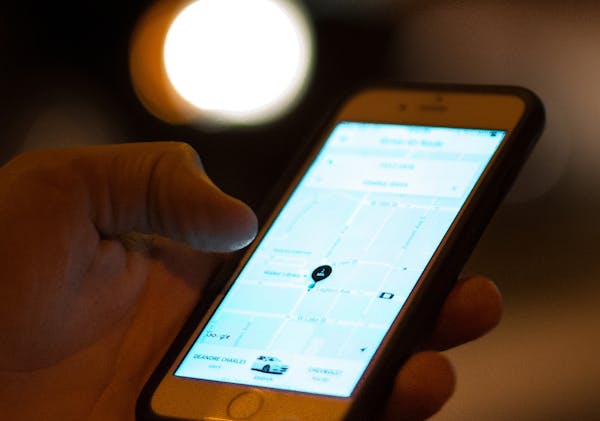Earlier this year, new rules overseeing taxicabs and ride-sharing firms, including UberX and Lyft, were proposed for the Minneapolis-St. Paul International Airport. Few could have predicted what a wrenching, regulatory journey it would prove to be.
Three public hearings over the course of nine months were held, and each morphed into a kind of transportation therapy session pitting taxi drivers against their upstart ride-share competitors. The last forum, in September before several hundred drivers, lasted close to five hours.
Proposed ordinances were retooled along the way, and the most recent version will be voted on by the Metropolitan Airports Commission (MAC) on Monday. If approved, the new regulations will take effect Jan. 1. Airport passengers using smartphone-enabled apps will likely find it easier to hail UberX and Lyft rides should the new rules be adopted.
The emotional debate over the past year was emblematic of how an emerging, technology-driven business model — ride-sharing — threatens a stalwart industry — in this case, taxi services, which date to the late 19th century.
As ride-sharing grows more popular in the Twin Cities, particularly among millennials and frequent travelers, MAC officials felt it was time to craft a legal framework to guide their operations. The MAC tried to balance the needs of both businesses.
"I was surprised because a lot of the drivers had strong personal stories about their families and children, about paying for school," said Rick King, a MAC member who chaired the hearings. "I really felt going in … that everyone should have a chance to talk."
At the September hearing, held in a Bloomington hotel ballroom, 70 people spoke. About 100 testified at two previous forums, and hundreds attended all of them. Some speakers faltered. A few teared up. Others shouted and then huffed off. Many testimonials never touched on the specifics of the new ordinance and veered into uncharted, and sometimes nonsensical, territory.
But mostly, taxi drivers spoke of the challenges of earning a living to support their families in a new country — many are immigrants from Africa. Uber and Lyft drivers discussed earning extra money as single parents, students and retirees struggling to make it on limited Social Security benefits. A few said they just enjoyed getting out of the house and meeting new people, so they drive.
The debate occasionally turned nasty. A taxi representative got booed when he said that the UberX and Lyft drivers looked nice, "but people thought [serial killer] Ted Bundy was a nice guy." Some UberX and Lyft drivers commented that taxicabs are not "clean" and the drivers "don't speak English."
Like a high school football game between dreaded rivals, drivers proudly donned their favored colors — orange for the Teamsters union, which represents the cabdrivers, hot pink for the Lyft drivers, and royal blue for UberX, the lower-cost Uber service.
"This is like the Denver Broncos, home and away," King quipped at July's hearing.
King said skills he learned as a Division I hockey referee as a young man helped him oversee the hearings. "You have to be very observant, quick acting and impartial," he said. "If you do it right, it diffuses the situation."
Other airports, including those in New York City and Las Vegas, faced a similar conundrum — with mixed results — when they drafted ride-sharing regulations. Earlier this year, voters in Austin, Texas, famously voted to require Uber, Lyft and other "transportation network companies" in the city to undergo fingerprint-based background checks. This came after sporadic reports nationwide of assaults involving Uber and Lyft drivers. As a result, the ride-sharing firms pulled out of Austin.
"When you try to regulate Uber and Lyft at airports, people will find ways around [the rules]," said Yash Babar, a University of Minnesota Carlson School of Management doctoral student who studies ride-sharing. "These laws are very difficult to impose."
Nationally, the software firm Certify found that Uber and Lyft accounted for nearly 49 percent of total ground transportation services in the second quarter of this year — a category that includes taxis and rental cars. Taxis accounted for just 14 percent in the survey, which analyzed more than 10 million business traveler receipts and expenses.
"With continued momentum in the corporate market and competition heating up it appears the ride-hailing trend is beginning to turn a corner," the survey stated. "For taxis nationwide, there may be no turning back."
Minneapolis was one of the first cities in the United States to enact ride-sharing regulations in 2014, and St. Paul followed several months later. MSP Airport closely studied the newly enacted regulations by the twin towns and took note.
"We looked at all kinds of models," said MAC Chairman Dan Boivin. "Every airport is doing something different."
The proposed ordinances retool existing taxi standards, calling for cabbies to pay an annual fee of $3,250, $100 lower than the current cost, and require cabs to accept credit cards. This appears to have satisfied most of the 700-plus cabbies serving the airport.
The ride-sharing ordinance requires drivers to pay $25 for a permit and sticker to display on vehicles serving the airport. Drivers must apply for the permit in person and show their driver's licenses as identification.
Both taxi and ride-sharing drivers must undergo a national criminal background check.
But the debate may not be over. In a statement last week, Uber said the current proposal "would put in place outdated and overly burdensome requirements that would make it more difficult for drivers to earn money and restrict options for consumers. We are committed to working with airport commissioners and staff to find a solution that embraces innovation and the unique aspects of ride-sharing while ensuring that ride-sharing continues to be an option for travelers at the MSP Airport."
Janet Moore • 612-673-7752 @MooreStrib

Trail section at one of Minnesota's most iconic spots closing for rehab

Will 'shotgun only' zone for deer in southern Minnesota be abolished?

Four Minnesotans catch salmonella in outbreak linked to basil sold at Trader Joe's

